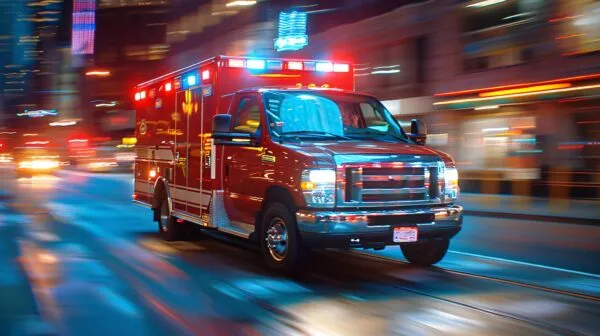Why it matters more than ever
For many of us in EMS, the sound of the siren and the flash of the lights are ingrained in our mindset: “This is a life-or-death call; we’re getting there fast.” But recent data and proposed policy changes are prompting a reassessment of that assumption.
In Wake County, North Carolina, the local EMS system recorded 21 ambulance crashes this year involving the use of lights and sirens, including two total vehicle losses (Murawski, 2025). Currently, about 80 percent of EMS responses in Wake County use lights and sirens, but officials hope to reduce that figure to 20 percent of calls under a proposed new policy (Murawski, 2025).
Wake EMS Director Jon Studnek noted that the use of lights and sirens should be viewed as a clinical intervention—appropriate only when a few minutes of saved time could meaningfully affect patient outcome (WRAL News, 2025).
This evolving philosophy challenges long-held beliefs in EMS and forces us to weigh risk versus benefit in a more deliberate way.
What the data suggest
-
Time saved: Studies show lights and sirens typically save two to three minutes on average (WRAL News, 2025).
-
Crash risk: Wake County reported 21 crashes this year involving ambulances using lights and sirens, two of which were total vehicle losses (Murawski, 2025).
-
Clinical significance: The time saved may only be clinically meaningful for patients in cardiac arrest, major trauma, airway compromise, or other time-critical conditions (WRAL News, 2025).
-
Policy intent: Wake EMS aims to use lights and sirens for approximately 20 percent of responses, aligning with national trends to improve safety without compromising care (EMS1, 2025).
What this means for EMS providers
-
Rethink automatic lights and sirens.
Just because it’s a 911 call doesn’t mean the lights must flash. Consider whether faster arrival will truly change the outcome. -
Engage in post-call reviews.
After each response, reflect on whether lights and sirens made a difference—or simply increased risk. -
Advocate for clear criteria.
Work with leadership to define evidence-based indications for lights and sirens, such as major trauma or cardiac arrest, versus stable or low-acuity calls. -
Adapt driving behavior.
Even with lights and sirens, intersection awareness and speed control remain vital. -
Communicate system-wide.
As Wake County’s proposed policy evolves, dispatchers, responders, and hospitals must understand the rationale behind reduced siren use (ABC11, 2025).
Benefits, challenges, and realities
Benefits
-
Fewer crashes and injuries to crews and civilians (Murawski, 2025).
-
Reduced vehicle loss and maintenance costs.
-
Safer operations and data-driven response models.
Challenges
-
Longer response times for low-priority calls (ABC11, 2025).
-
Cultural resistance among EMS crews who equate siren use with urgency and professionalism.
-
Managing public expectations when ambulances arrive quietly.
Realities
-
Each system must tailor criteria to its geography, call volume, and traffic conditions.
-
Wake County plans to phase in the new policy by March 2026 (Murawski, 2025).
-
Data collection and evaluation are essential to determine whether reduced siren use improves overall outcomes.
Action steps for EMS agencies
-
Audit lights and sirens usage: Review the last 12–24 months of responses to determine when the intervention was truly necessary.
-
Develop decision criteria: Create a response matrix considering patient condition, mechanism, and urgency.
-
Train providers: Use simulation and scenario-based learning to emphasize safe non-siren driving.
-
Inform the public: Develop educational messaging explaining why EMS may arrive without lights or sirens for non-critical situations.
-
Monitor outcomes: Track crash rates, response times, and clinical outcomes.
Conclusion: A culture shift, not a compromise
The Wake County discussion underscores that safety and effectiveness are not mutually exclusive. Using lights and sirens less frequently doesn’t make EMS less urgent—it makes it smarter and safer.
When lights and sirens are viewed as a treatment modality, reserved for calls where seconds matter, we elevate our professionalism and protect both our crews and communities.
As EMS evolves, so must our culture. The goal is not simply to arrive fast—it’s to arrive safely and deliver excellent care every time.
References (APA 7th Edition)
ABC11. (2025, October 14). Wake County EMS may reduce use of lights and sirens to improve safety.
https://abc11.com/post/emergency-nc-ems-lights-sirens-use-reduced-effort-increase-response-times-low-acuity-calls-wake-county/18078143
EMS1. (2025, October 13). N.C. EMS considers limiting use of lights, sirens to reduce crashes.
https://www.ems1.com/ambulance-safety/n-c-ems-considers-limiting-use-of-lights-sirens-to-reduce-crashes
Murawski, J. (2025, October 12). Wake County proposes limiting use of lights, sirens on ambulances after crashes. The News & Observer.
https://www.newsobserver.com/news/local/counties/wake-county/article312674597.html
WRAL News. (2025, October 11). Wake County EMS eyes policy to reduce use of lights and sirens after multiple crashes.
https://www.wral.com/news/local/wake-county-ems-ambulance-siren-lights-policy-change-october-2025/

